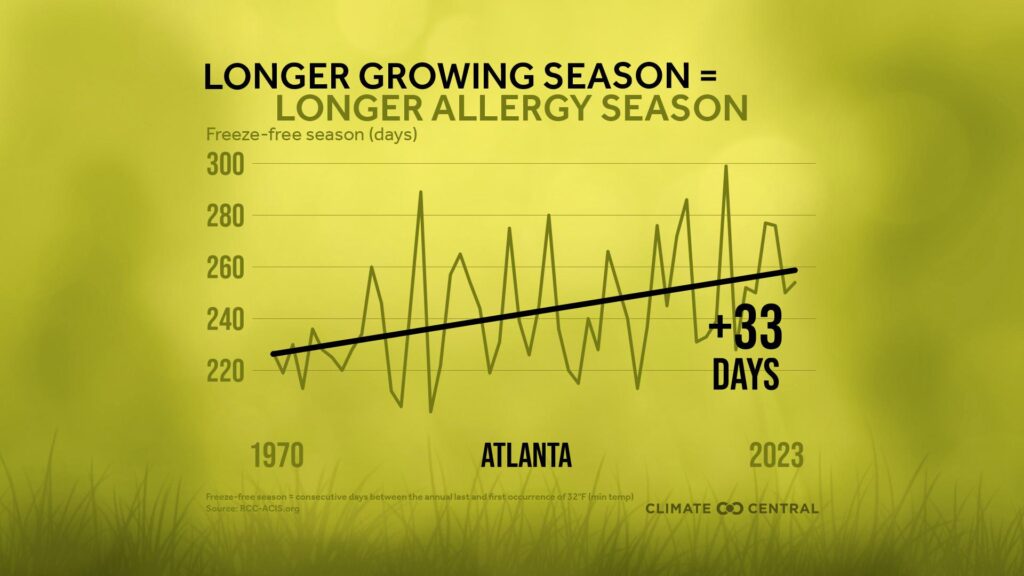There’s something in the air.
Spring heralds the awakening of nature from its hibernation, and everything begins to green and bloom. The longer days and burgeoning life around us can uplift the mood and evoke a sense of vitality and renewal.
However, the warming rays of sunshine and burgeoning greenery do not elicit feelings of joy for everyone. Spring is also the season when the first pollens float through the air, marking the beginning of allergy season. Allergies are “the most prevalent chronic conditions worldwide”: “Over 10 million adults, along with approximately 1.5 million children and adolescents, suffer from seasonal symptoms during pollen season in Germany. Additionally, there is an unaccounted number of individuals who develop allergic bronchial asthma triggered by pollen”.
An increasing number of people suffer from allergic conditions such as hay fever, and “their numbers are expected to rise significantly in the coming decades”, according to the Robert Koch Institute. “The frequency of allergic diseases has increased sharply since the 1970s in countries with a Western lifestyle and has stabilized at a high level”, and the occurrence of asthma “continues to rise”. Allergy symptoms range from mild discomfort such as sneezing and rashes to serious problems like breathing difficulties and asthma attacks.
However, in addition to the “personal limitations”, there are “impacts on the entire society” because “the decrease in productivity due to allergies should not be underestimated”. Consequently, across Germany, there are “annual absenteeism of one million working days”, with “one in ten sick leaves in Germany attributed to allergies”, and nationwide, “30,000 young people terminate their education due to allergies”. The “avoidable costs due to production reduction from untreated allergies are estimated at around 100 billion euros throughout Europe”.

Photo: Meiying Ng
The Allergy Season and Climate Change
Climate change and its consequences—rising temperatures, air pollution, (extreme) droughts, and urban sealing—favor allergies and exacerbate allergy symptoms. As early as 2009, Tagesschau pointed out that climate change and therefore “mild winters, summer-like temperatures already in April, and little rain in the summer” in Germany can lead to increased allergy potential.
Photo: Climate Central
HotSpot City
Those most affected are often children, individuals with pre-existing conditions, and the elderly, with urban dwellers suffering more and more intensively from the effects than those in rural areas. This can have far-reaching consequences, as those “who constantly have to sneeze or feel exhausted may also have difficulty concentrating in school”.
The reason for the increased and more pronounced occurrence of allergens and the “higher allergic potential”: Plants produce more pollen as a stress response, e.g. due to the increase in CO₂ levels, poor air quality with high pollutant concentrations, and urban stress factors such as “drought stress” due to sealed surfaces and water scarcity. This is demonstrated by the Allegra Allergy Atlas (Allegra Allergieatlas), “a representative survey by Bilendi on behalf of Sanofi”, with the telling subtitle: “Allergies don’t take a winter break”.
“Furthermore, emissions-related higher concentrations of NO₂ can lead to the formation of new allergens in pollen, which in turn adhere to particulate matter and diesel exhaust particles”, as APOTHEKE ADHOC reported.
It should be noted that pollutant exposure, for example, through soot, not only influences plants and allergy potential, as Tagesschau already reported in 2009: Those who live “close to main roads […] react more frequently and severely to pollen”. In this context, “pollen allergy is becoming an increasingly significant problem for humans, especially in regions where the level of air pollution is rising due to traffic and urbanization” (The Guardian). Last year, we already asked: “Do you live in an environment with high air pollution?” Because if so, the allergy season could be worse. According to a study published in PLOS One in 2023, air pollution can make pollen more allergenic.

Photo: Maria Hossmar
Effective Solutions?
Effective measures or solutions are currently proving difficult to implement, often leaving only medical aids. “Against the symptoms, sufferers can use nasal sprays, eye drops, and tablets”, while an immunotherapy, such as injections or tablets (desensitization), addresses “the cause”.
However, there are some opportunities offered by a changed green planning in urban areas. The use of female specimens or varieties with a short flowering period opens up possibilities, especially regarding tree plantings, but the realization is more complex, especially outside the private sphere, for grasses and herbs.
The “Pollen Foundation” („Pollenstiftung“) points out that “even ambitious mowing programs by cities and municipalities cannot provide real protection for allergy sufferers”, affecting “the flowering of grasses and herbs such as mugwort”. The “International Ragweed Day” even highlights “the need to combat this plant – both in the media and politically”.
Also, the fact that trees “can physiologically adapt to the local environment” does not protect against the production of “more stress proteins of higher potential allergenicity”, as reported by The Guardian. The recommendation: to avoid planting altogether or to “at least choose varieties that only spread pollen for a short period”. Because, as Transforming Cities warns, even “a small percentage of highly allergenic plants in the total stock of a park [is enough] to still cause a high potential”.
And “allergy sufferers should also have access to green spaces without exposing themselves to very high health risks”. The “Pollen Foundation” (Pollenstiftung) therefore advocates that “urban planning […] now more than ever, requires a focused allergological perspective”.

Photo: GCS
Alternatives to Established Urban Greening
At Green City Solutions, we want to help people in particularly burdened urban areas breathe fresh air and thus improve their health and quality of life. To this end, we rely on fresh air zones that can contribute to mitigating the effects of climate change thanks to the natural and remarkable abilities of specialized mosses. Innovative nature-based systems offer themselves as ideal complements within urban green planning.
Used correctly, our solution can help reduce heat islands, capture particulate matter from the air, and support rainwater management.
But even concerning the potential for allergies, our natural air filters and coolers offer advantages:
Photo: GCS


